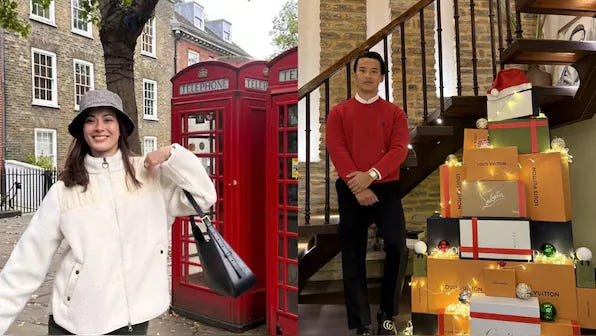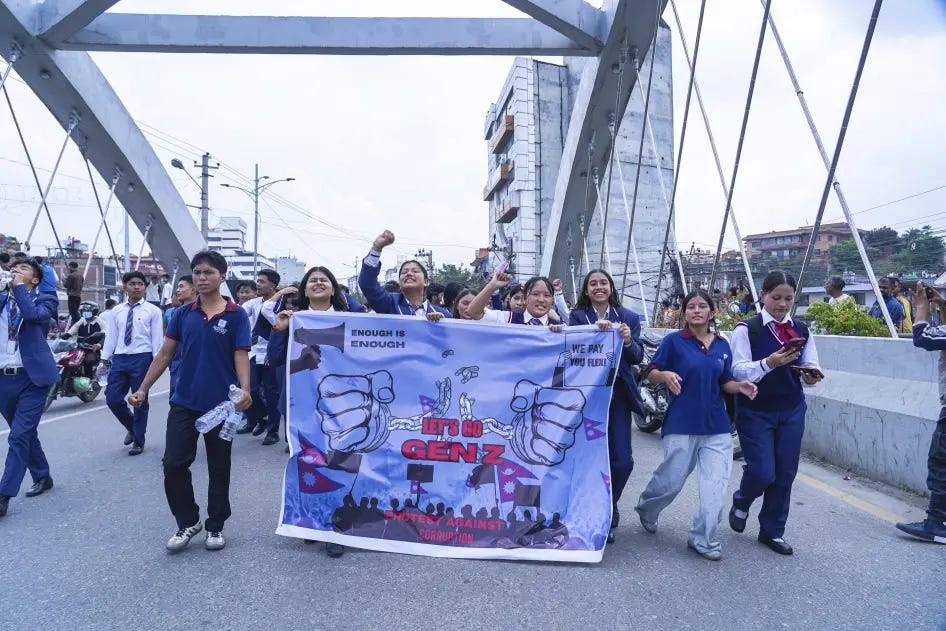The #NepoKids Ignites Digital Outrage
Around early to mid-August, politically affiliated wealthy individuals in Indonesia found themselves being called out on social media platforms, being called out for their flaunting of lavish lifestyles while the majority of the population were facing hardships due to rising inflation costs, high taxes, and low minimum wages. The politicians were receiving multiple benefits in addition to their wages, 10 times their minimum wage, just for living allowances. Indonesians started their rebellion and poured out their grievances, and a social media trend #NepoKid became viral.
In Nepal, there is a similar situation. The new minimum wage, revised just this year, is NPR 19,550, which is barely enough to feed a family. The GDP per capita is at USD$1,447.31, approximately. I.e, NPR 2 lakhs is the average amount earned by a Nepali citizen in a year, placing us 103rd out of 193 countries in the world.
Parliament Members have a monthly salary of NPR. 66,420/month, while Ministers have a salary of NPR. 72,730. The highest salary, earned by the prime minister, is NPR. 77,640, with a dearness allowance of around NPR. 20,000. Amidst this, Ministers, Politicians, and their children are flaunting luxurious lifestyles, quarterly vacations to Europe, and expensive cars, accessories, and brands.
The citizens asked only one question. Where was this money coming from?
Around late August, the #NepoKid trend went viral, with hundreds of thousands of posts. The viral social media movement labeled #NepoKids and #NepoBabies exploded across Nepali social media platforms, including TikTok, X, Instagram, and Facebook.
Nepali Gen-Z users researched into the social media lives of politicians’ and ministers’ children, dubbing them “nepo kids” who flaunted luxury cars, designer clothes, and lavish vacations allegedly funded by public corruption of taxpayers’ money.

Social Media posts of politicians’ children flaunting extravagant lifestyles and luxury via AP.
So where did the funds for the X-mas tree of designer handbags or the around-the-world vacations come from?
It was clear. They were allegedly funded by public corruption of taxpayers’ money.
The alleged NepoKids were called out on social media and defamed for their unapologetic behavior, alongside their shamelessness for treating the corrupted money as their privilege, while over 20% of the nation lives below the poverty line. The NepoKids soon made their social media accounts private, while the trend became more viral.
The Social Media Ban: The Public’s Last Straw
On 25th August, ICT Minister Prithvi Subba Gurung announced a possible social media ban, citing concerns regarding the misuse of social media, and demanded that the social media platforms (YouTube, Facebook, Reddit, Instagram, Discord, etc.) comply with the government’s instructions and follow the full procedure of handing over censorship rights, among others, to the IT Ministry. The total list ban-list included 26 social media platforms, excluding TikTok, among others.
After the 26 platforms missed the one-week ultimatum, the ICT ministry ordered Nepal Telecom to instruct the Internet Service Providers (ISPs) to block access to the list of banned platforms, taking effect on the evening of 3rd September.
The timing of the ban was very unusual. Right around the time the #NepoKids trend went viral, politicians and their kids were called out and defamed. The ICT ministry coincidentally had to enforce its Social Media Regulation Directive 2080 B.S two years after its release.
To the public, it was a clear act to suppress the voices of the citizens and the #NepoKids trend, and try to prevent further exposure of corruption by elite officials. This move backfired spectacularly: silencing voices was answered with Virtual Private Networks (VPNs) and Domain Name Servers (DNS) breakthroughs.
For the Gen-Z and youths, this ban symbolized decades of oppression, where youth unemployment (more than 20% for youths aged 15-24) and economic stagnation from cronyism and corruption fueled a “pressure cooker” of frustration and disappointment amongst Generation Z (1997-2012), who make up almost 40% of the 30 million Nepalese population. With the ban, social media influencers and digitally savvy youths started to speak up with the use of VPNs and DNS proxies, which the government couldn’t silence.
The youths spread the word of peaceful protest against corruption and unfair practices happening in the governance, including frequent government collapses (13 in the last 15 years), rampant bribery in public services, and elites controlling sectors like banking and media, while their children flaunted lavish lifestyles in the face of hardworking citizens earning day-to-day to earn a living.
Under the comments of viral TikToks, Instagram, and Facebook reels, the word of peaceful protest on 8th September spread across hundreds of thousands of youths and millions of Nepalese. Organizations like HamiNepal promoted the protest, with various little-known leaders leading the protests.
The peaceful protest was declared official on September 7 as the Kathmandu Metropolitan allowed it to be held in the premises of Maitighar Mandala.
The Storm of Revolution

Students protest against blatant corruption and the government’s undemocratic ban on social media platforms in Kathmandu, Nepal, on September 8, 2025. © 2025 Ambir Tolang/NurPhoto via AP.
On September 8th, 8 large rallies against the government took place. Kathmandu hosted the largest one, limited to Maitighar Mandala. Other gatherings took place in Birgunj, Bhairawaha, Butwal, Pokhara, Itahari, and Damak.
Gen-Z students and youths rallied across in their student uniforms from 9 a.m. onwards, wearing their ID cards, and expressing their grievances towards the government peacefully. Many were chanting humorous slogans, and others were doing fun and peaceful activities, including dancing, playing cards, and singing songs, among others.
In just a few hours, around the peak of 12 p.m., crowds swelled to over 15,000 in the Maitighar area. With lowering spaces, the youths began pushing towards the barricade of Maitighar, on the main road facing towards Baneshwor. Surprisingly, the police barricade was easily overthrown, and the Armed Police Force retreated, which should not have been the case. The expanding rally, suffocating and searching for space, moved towards the Parliament road in Baneshwor. Although it was a peaceful rally, the demonstrations escalated as the group reached the Parliament area and blocked the road.
To control this, the APF deployed water cannons from the Baneshwor bridge, and by afternoon, they had started using tear gas and rubber bullets to control the protesters, leading the rally into chaos.
The Tragedy of September 8th

Protesters getting shot using real bullets in front of the Federal Parliament, Baneshwor, Kathmandu, Nepal, on September 8, 2025 via AP.
Around 2 p.m., as the crowd broke into the parliament resisting the APF, a shoot-on-sight order was given to the Armed Police Force (APF) by the CDO Chabi Rijal in case of destruction of public property.
This was unusual. How was the APF not capable of controlling unarmed protesters with crowd control mechanisms? Rubber bullets, Tear Gas, and Water Canons could have been used more efficiently and in larger numbers, but the CDO gave a shoot-on-sight order.
17 Gen-Z students were shot dead in front of the Parliament in Kathmandu. 2 were shot dead in Itahari.
The majority of what the rubber bullet APF claimed was real ammunition, shot directly in the head and fatal areas of the body. Among the majority shot dead, the majority were in school uniforms and wearing ID cards, unarmed and incapable of harming the so-called “public property”.
The actions of APF and the shoot-on-sight orders were highly unethical and unlawful. 19 were directly shot dead, while 32 were shot lethally and are in critical condition. By evening, 21 were martyred. As the crowd was disrupted due to the brutality of APF’s actions, news spread and sparked a large commotion online.
Major INGOs like Human Rights Watch and UN Human Rights condemned the “unnecessary or disproportionate use of force,” calling for a transparent investigation, and as international embassies (from the US, UK, Japan, and others) expressed shock over the killings, urging restraint and accountability.
The confrontations of September 8 resulted in at least 21 people killed and 347 people injured.
On the evening of 8th September, the government lifted the ban on social media platforms altogether. Home Minister Ramesh Lekhak resigned on “moral grounds”, and a curfew was imposed in 8 major cities where the rallies took place.
The same evening, all news channels were called out internationally to cover the violation of human rights and the heavy-handed and bloody crackdowns instigated by the Nepalese government.
